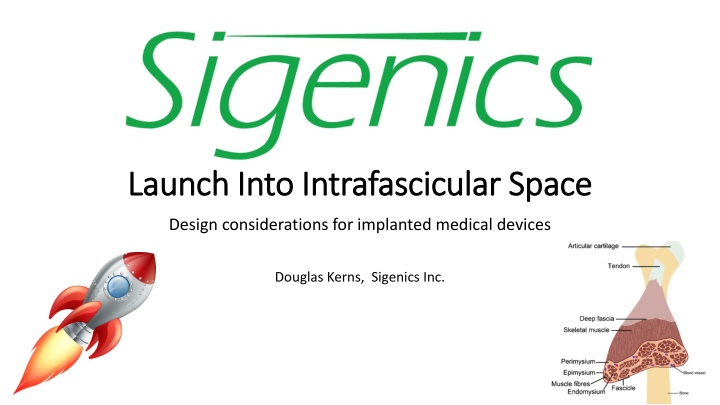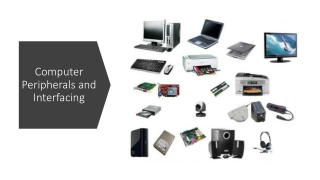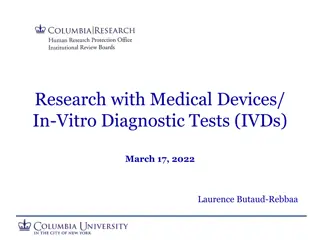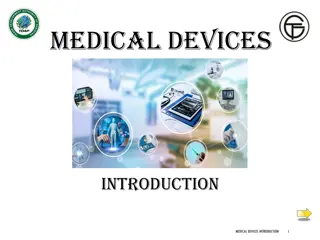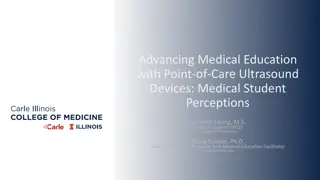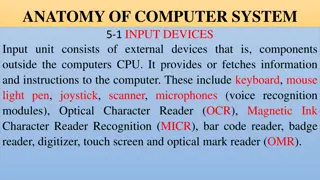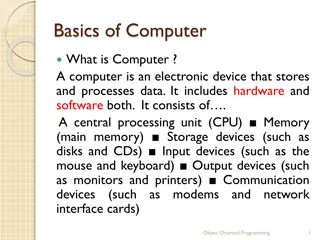Design Considerations for Implanted Medical Devices
Implanted medical devices play a crucial role in fixing broken hearts, teeth, and bones. Safety and efficacy are paramount in designing these devices, with a focus on minimizing invasiveness, using biocompatible materials, and implementing secure operating protocols to ensure patient well-being.
Download Presentation

Please find below an Image/Link to download the presentation.
The content on the website is provided AS IS for your information and personal use only. It may not be sold, licensed, or shared on other websites without obtaining consent from the author.If you encounter any issues during the download, it is possible that the publisher has removed the file from their server.
You are allowed to download the files provided on this website for personal or commercial use, subject to the condition that they are used lawfully. All files are the property of their respective owners.
The content on the website is provided AS IS for your information and personal use only. It may not be sold, licensed, or shared on other websites without obtaining consent from the author.
E N D
Presentation Transcript
Launch Into Launch Into Intrafascicular Intrafascicular Space Space Design considerations for implanted medical devices Douglas Kerns, Sigenics Inc.
Implanted medical devices have a variety of functions fixing broken hearts fixing broken teeth fixing broken bones FSW 2014 Launch into Intrafascicular Space: Design considerations for implanted medical devices 2
Sigenics makes integrated circuit microelectronics. What s so great about integrated circuits? Lithographic manufacturing (printing!) process make ICs a very inexpensive method for manufacturing huge quantities of electronic devices. Microscopically small features make ICs a very effective method for reducing size, weight, and power of electronic devices. This is a key item for implanted medical electronics! FSW 2014 Launch into Intrafascicular Space: Design considerations for implanted medical devices 3
The primary constraint on medical devices is SAFETY Do no harm! FSW 2014 Launch into Intrafascicular Space: Design considerations for implanted medical devices 4
The primary constraint on medical devices is SAFETY Do no harm! The primary requirement for medical devices is EFFICACY Do some good! FSW 2014 Launch into Intrafascicular Space: Design considerations for implanted medical devices 5
In general, how are safety and efficacy rendered in an implanted medical electronic device? SAFETY = minimize surgical invasiveness during and after implant small implant size biocompatible materials minimize or eliminate secondary surgeries for repair or replacement FSW 2014 Launch into Intrafascicular Space: Design considerations for implanted medical devices 6
In general, how are safety and efficacy rendered in an implanted medical electronic device? SAFETY = minimize surgical invasiveness during and after implant SAFETY = choose operating and communication protocols to avoid unsafe conditions As much as possible: Limit the scope of autonomous machine actions Limit the impact of autonomous machine actions Use handshake protocols for control communications FSW 2014 Launch into Intrafascicular Space: Design considerations for implanted medical devices 7
In general, how are safety and efficacy rendered in an implanted medical electronic device? SAFETY = minimize surgical invasiveness during and after implant SAFETY = choose operating and communication protocols to avoid unsafe conditions SAFETY = design safe failure modes for hardware, software, protocols safe under any single-point failure positive good diagnostic indicators wherever practical FSW 2014 Launch into Intrafascicular Space: Design considerations for implanted medical devices 8
In general, how are safety and efficacy rendered in an implanted medical electronic device? SAFETY = minimize surgical invasiveness during and after implant SAFETY = choose operating and communication protocols to avoid unsafe conditions SAFETY = design safe failure modes for hardware, software, protocols EFFICACY = whenever possible, design for continued function under partial failure handshake-and-correct communication protocols survive single-channel damage or failure safe single-channel shutdown FSW 2014 Launch into Intrafascicular Space: Design considerations for implanted medical devices 9
Example: epilepsy ElectroCorticoGram (ECOG) array Current Method: Current Method: New Method New Method Wirelessly powered Wirelessly powered Skull is closed during monitoring Skull is closed during monitoring 64 recording and stimulation channels 64 recording and stimulation channels Up to 1Mbps reverse telemetry rate Up to 1Mbps reverse telemetry rate Iridium oxide electrodes deposited on Iridium oxide electrodes deposited on flexible polyimide substrate flexible polyimide substrate Silicone chip and coil encapsulation Silicone chip and coil encapsulation FSW 2014 Launch into Intrafascicular Space: Design considerations for implanted medical devices 10
We lose physical access to the device after it is implanted it s been launched SAFETY: In the worst case, we want the implanted object to do no harm. All exterior surfaces must be biocompatible Worst-case electrical failure yields an inert mechanical object EFFICACY: Observability and controllability of the implanted electronics Status reporting for operational variables per-channel diagnostic functions per-channel shutdown FSW 2014 Launch into Intrafascicular Space: Design considerations for implanted medical devices 11
Up link to the implanted device wireless power supply (look Ma, no batteries!) small size (small tissue displacement when inserted) small mass (small tissue disturbance during patient motion) no need to replace the batteries (eliminate subsequent surgeries) limited electrical energy delivery Forward communication protocol At most one stimulation pulse per command Forward error control coding in packet wrapper Handshake command protocol By design, we avoid a variety of unsafe conditions FSW 2014 Launch into Intrafascicular Space: Design considerations for implanted medical devices 12
Down link from the implanted device multiple communication bands dodge external interference compensate for marginal power supply conditions flexible communication protocol structured error control coding detailed reporting of uplink errors programmable packet framing and payload structures By design, we can recover from a variety of partial failures FSW 2014 Launch into Intrafascicular Space: Design considerations for implanted medical devices 13
Operational features of the implanted device Finite state machine controller exhaustively verifiable all states lead to INIT no action response to garbled uplink command Fail-safe hardware features all i/o terminals passively clamped inside water window no single-point failures can connect power directly to electrode per-channel disable-and-disconnect FSW 2014 Launch into Intrafascicular Space: Design considerations for implanted medical devices 14
Graphics credits This presentation used artwork obtained via CanStockPhoto from the following artists: Krisdog, Roxanabalint p1 Khuruzero, Eraxion, Ingridat p2 Scanrail p3 Pixdesign123 p4 Pixdesign123 p5 FSW 2014 Launch into Intrafascicular Space: Design considerations for implanted medical devices 15
